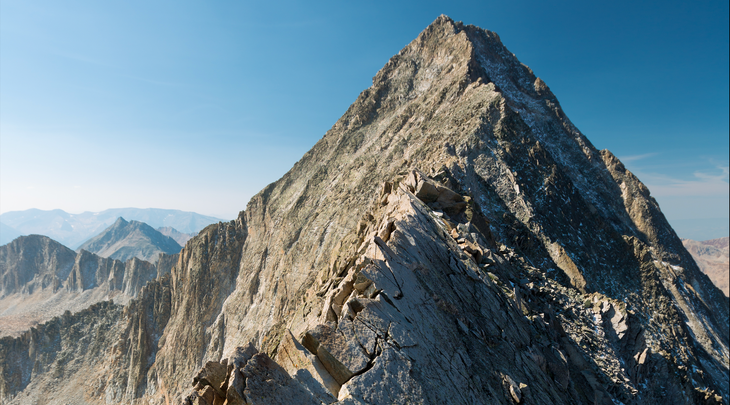Three Mountain Rescuers Were Injured Attempting A Body Recovery on Capitol Peak


Three members of Mountain Rescue Aspen (MRA) were injured, one seriously, on August 4, attempting to recover the body of a 32-year-old man who had fallen from the notorious Knife Edge traverse on Capital Peak, a fourteener 18 miles southwest of Carbondale, Colorado.
Capitol Peak (14,130 feet) sits in the Elk Range east of Aspen and is one of the most technically challenging of Colorado’s 14ers. The only non-technical route up the mountain is the Northeast Ridge, which requires navigating the Knife Edge, a long section of thin and crumbling ridgeline with over a thousand feet of exposure on either side. In a six-week period in the summer of 2017, five people—some of them experienced climbers—fell to their deaths on Capitol Peak.
What happened
On Sunday, August 1, 32-year-old Kelly McDermott, a native of Madison, Wisconsin, was reported missing on Capitol Peak. He had attempted the mountain with several friends the day before, but they were turned around by wet conditions, according to the Aspen Times. After returning to his car that evening and noting that the weather had cleared, McDermott decided to sleep in the parking lot and, if conditions seemed reasonable in the morning, try again by himself. When he failed to return on Sunday night, the Pitkin County Sheriff’s Office put the search process in motion.
The search for McDermott consisted of MRA volunteers aided by helicopters from the Army National Guard and CareFlight of the Rockies. They searched through Monday and Tuesday, their efforts periodically obstructed by rain and low clouds. By Wednesday morning, there were 23 volunteers combing the mountain’s approaches and two helicopters searching its upper slopes. Shortly before 10:00 a.m. a HAATS Blackhawk helicopter operated by the Army National Guard “spotted McDermott roughly 500 feet below the south end of a ridge known as the ‘Knife Edge,’ near the summit of Capitol Peak,” according to a statement released by the Pitkin County Sheriff’s Office. “It appeared as though McDermott had fallen and sustained fatal injuries.”

At roughly the same time as four MRA volunteers began climbing up toward McDermott’s body from Pierre Lakes, a party of hikers began traversing the unstable southern end of the Knife Edge directly above them. In an attempt to minimize risk of rockfall, the pilot of the Blackhawk hovered above the hikers and “motioned for the recreational climbers to move off the ridge, but the climbers didn’t appear to understand the request,” according to the statement. (One takeaway from these events: If someone in a helicopter seems to be trying to communicate with you in the mountains, chances are they want you to hold off on what you were doing.)
Minutes later, the MRA volunteers heard someone shouting “Rocks!” just as “an avalanche of rocks” crashed down upon them. Though one volunteer was able to avoid injury, the other three were caught in the slide. Two of them suffered minor and moderate injuries, but a third was thrown “roughly twenty feet through the air in a ‘rag doll,’ or somersault motion.”
Climbing contacted Mountain Rescue Aspen for more details, but they declined to comment.
All four MRA members were airlifted off the mountain by the HAATs Blackhawk. The two members of the MRA team with minor injuries were released from the hospital that same day—but the third suffered far more serious injuries, including “a comminuted femur fracture, multiple pelvis breaks and a fractured vertebrae,” according to a text message published by the Aspen Times with the injured MRA member’s permission. She will require months of rehab and physical therapy.
Increased traffic on Colorado’s highest peaks
Colorado’s high mountains have seen a significant spike in foot traffic over the last few years. According to the Colorado Fourteeners Initiative, a nonprofit that aims to minimize the impact of visitors on Colorado’s highest peaks, 353,000 people climbed on 14ers in 2018. This number declined in 2019 because of the short season, but then jumped by nearly 20% to 415,000 in 2020, thanks to COVID-19. Some of the more popular peaks saw 70% increases in traffic.
This increase in popularity has search-an-rescue teams around the country scrambling to meet demand for rescue. (For more on this topic, see Michael Levy’s “Was I Wrong To Call For a Rescue?”) And while the vast majority of these calls come from mountain novices who make avoidable mistakes and then lack the knowledge and resources to get themselves home safely, it’s important for expert climbers to remember that mountain accidents don’t just happen to the inexperienced. McDermott, for instance, whose body is still awaiting retrieval, had, according to friends, summited a number of high mountains in the United States.
This article is free. Sign up with a Climbing membership, now just $2 a month for a limited time, and you get unlimited access to thousands of stories and articles by world-class authors on climbing.com plus a print subscription to Climbing and our annual coffee-table edition of Ascent. Please join the Climbing team today.
The post Three Mountain Rescuers Were Injured Attempting A Body Recovery on Capitol Peak appeared first on Climbing.

